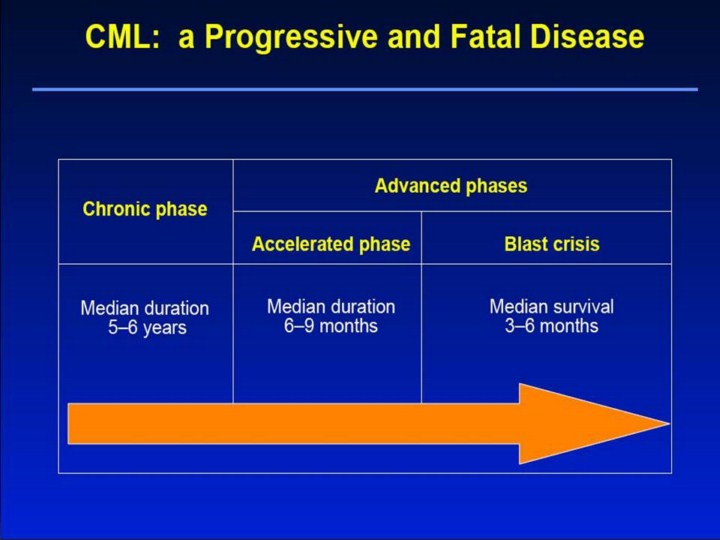| front |1 |2 |3 |4 |5 |6 |7 |8 |9 |10 |11 |12 |13 |14 |15 |16 |17 |18 |19 |20 |21 |22 |23 |24 |25 |review |
 |
CML: a Progressive and Fatal Disease CML progresses through 3 phases of shortening duration characterized by worsening clinical features and laboratory findings and increasing refractoriness to therapy. These stages include chronic phase, accelerated phase, and blast crisis. The majority of patients present in chronic phase and then progress to accelerated phase; however, 25% to 40% of patients progress directly from chronic phase to terminal blast crisis without evidence of a transitional accelerated phase.1,2 • Chronic phase. There are less than 10% to 15% blasts in peripheral blood and bone marrow, and the white blood cell (WBC) count at presentation is typically elevated to ≥20 x 109/L. The cutoff for blasts in all Novartis studies was 15%. Signs and symptoms may initially be mild and develop as the disease progresses. The chronic phase of CML may last 5 to 6 years before the disease accelerates.1,3,4 • Accelerated phase. There are more than 10% to 15% (but less than 30%) blasts in peripheral blood or bone marrow. The less favorable cutoff of 15% was used in all Novartis studies. Symptoms may increase and include unexplained fever, bone pain, splenomegaly, and hepatomegaly. Basophilia, decreased platelet counts, and cytogenetic progression may also be observed. Cytogenetic abnormalities such as duplication of the Ph chromosome, iso17q, or trisomy 8 (+8) are the most common additional chromosomal abnormalities described during cytogenetic progression. The accelerated phase may last 6 to 9 months.1,3 • Blast crisis. There are more than 30% blasts in peripheral blood or bone marrow and increased symptomatology, especially relating to anemia and infection, central nervous system (CNS) disease, lymphadenopathy, and bleeding. Approximately 50% of patients have myeloid blast crisis, 25% have lymphoid blast crisis, and 25% are mixed.5 Patients with CML in blast crisis have a poor prognosis because of the lack of effective therapy. This phase is rapidly fatal, with a median survival of 3 to 6 months.2,5 References 1. Hill JM, Meehan KR. Chronic myelogenous leukemia. Curable with early diagnosis and treatment. Postgrad Med. 1999;106:149-152, 157-159. 2. Faderl S, Kantarjian HM, Talpaz M. Chronic myelogenous leukemia: update on biology and treatment. Oncology (Huntingt). 1999;13:169-180. 3. Faderl S, Talpaz M, Estrov Z, et al. Chronic myelogenous leukemia: biology and therapy. Ann Intern Med. 1999;131:207-219. 4. Pasternak G, Hochhaus A, Schultheis B, et al. Chronic myelogenous leukemia: molecular and cellular aspects. J Cancer Res Clin Oncol. 1998;124:643-660. 5. Cortes JE, Talpaz M, Kantarjian H. Chronic myelogenous leukemia: a review. Am J Med. 1996;100:555- 570. |